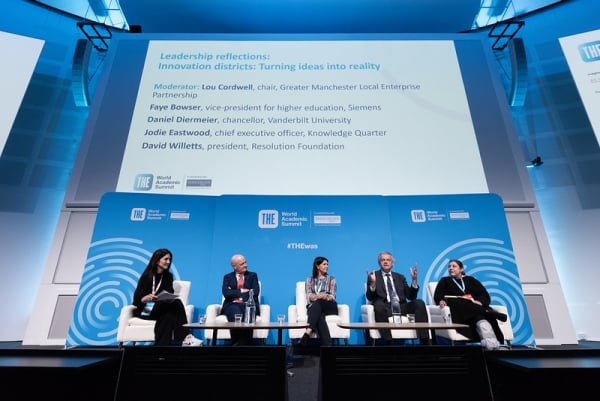Pictured (from left): Lou Cordwell of the Greater Manchester Local Enterprise Partnership moderated the panel, featuring Faye Bowser, vice president for higher education at Siemens; David Willetts, president of the Resolution Foundation and the U.K.’s former minister of state for universities and science; Daniel Diermeier, chancellor of Vanderbilt University; and Jodie Eastwood, chief executive officer of the Knowledge Quarter in London.
Innovation districts—traditionally created through collaborations between cities, industry and research universities—are evolving to keep pace with rapid advancements in technology and an increasing need for social impact.
But even as the makeup of innovation hubs changes, the agglomeration of intellectual creativity, a permeable relationship between higher education institutions and local communities, and business-friendly governmental polices remain at the center of successful knowledge economies, education and industry leaders have said.
Speaking at Times Higher Education’s World Academic Summit, Faye Bowser, vice president for higher education at Siemens, said the technology conglomerate is moving away from singular relationships with universities and toward fostering ecosystems around the world that include start-ups, research institutes and universities all focused on regional needs that link to global impact.
The way that academia and industry have worked together for decades has changed dramatically, she said, and in a “rapidly changing world,” there are two major differences. “One is about the speed of innovation and one is about the impact of innovation—we are being much more purpose-driven.”
In the U.S., innovation districts, epitomized by coastal hot spots in Silicon Valley and Cambridge, Mass., are popping up in unexpected regions. One of Siemens’s four research ecosystems in the United States, for example, is located in Atlanta, and includes partnerships with the Georgia Institute of Technology, Virginia Tech, the University of North Carolina at Charlotte, Oak Ridge National Laboratory and North Carolina A&T State University.
Being a destination for talent is part of what makes innovation districts thrive. “Many people in Europe do not fully appreciate the relocation of talent and capital that’s happening in the United States right now,” Daniel Diermeier, chancellor of Vanderbilt University, told the summit, held at the University of Manchester in England.
“There is an exodus from the coastal areas—California, New York—and the Midwest to the area starting in Texas, all the way to Florida with a stop in Tennessee. And that is driven by the fact that this is an attractive destination for people to live and work and do business.”
CNBC recently ranked Florida, Texas, North Carolina, Georgia and Tennessee among the top 10 states for business in America based on metrics such as the tax climate for businesses, the number of patents issued per capita, how many higher education institutions a state has and long-term trends in state support for higher education.
The country’s traditional centers of innovation should start waking up to this trend, Diermeier said. “I think there is a sense that you can just take this for granted—[they think] ‘We have this great city and everything is going to be fine.’ If you’ve spent some time in San Francisco in the last few years, that should be a lesson for everybody on how quickly the tide can turn.”
At a time of deep political division in American society and polarizing state policies on a number of hot-button issues, including abortion and LGBTQ+ rights, Diermeier told Inside Higher Ed that Tennessee’s politics haven’t affected Vanderbilt’s ability to attract faculty and research talent. “Politics are complicated wherever you are; it just comes in different flavors. There are aspects of Tennessee politics that are complicated and aspects of New York State politics that are complicated, and people have to weigh that and decide where they want to be.”
A university engaged with its community and local industry is also important for successful innovation districts, the panel noted. “Anything that makes universities more permeable and accessible and not totally focusing on new ideas will help foster innovation hubs,” said David Willetts, the U.K.’s former minister of state for science and universities.
He called for less focus on start-up culture, saying universities can contribute to innovation in other ways, including through contracted research for industry partners.
While Nashville is known as Music City, it also has an economy built on health-care management, the biomedical sector and the automotive industry. Vanderbilt’s approach to building trust with these sectors and being open to any type of collaboration has resulted in executive and continuing education, civic partnerships and innovation projects. “We don’t know what their problems are and they don’t know what our solutions are, so it’s a bit of a matching process,” Diermeier said.
A third element of success for new innovation districts is government policies that support innovative growth, either for industry in general or through strategic investments in a particular sector.
“If you’re a mayor or state that’s entrepreneurial, you can make tremendous positive impact in a short period of time,” Diermeier told Inside Higher Ed.
But despite the potential economic gains innovation districts can bring to their communities, they will do little to shift public perceptions about the value of higher education institutions on their own.
“We need to do the right thing around innovation and then talk about it,” Diermeier said. “The partnerships with municipalities and innovation economies are hugely important. People need to understand that the great research universities are educational institutions but also generators of tremendous intellectual capital and innovation. That’s the source of the prosperity of the country.”

